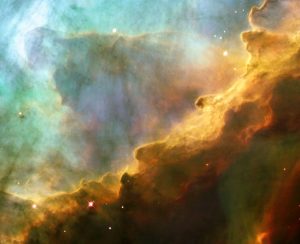La Tempesta Perfetta
Come la furia di un mare in tempesta, questa immagine del telescopio Hubble mostra un oceano ribollente di gas nella massiccia e luminosa nebulosa molecolare Messier 17. L’immagine riprende solo una piccola regione all’interno di Messier 17, una culla dove nascono stelle. Conosciuta anche come Nebulosa Omega, o Nebulosa Cigno, è localizzata a circa 5500 anni luce dalla Terra nella costellazione del Sagittario.
Le formazioni simili a onde sono state scolpite e illuminate da un torrente di radiazione ultravioletta emessa da giovani stelle massicce (localizzate al di fuori dell’immagine, in alto a sinistra), che scava e riscalda le superfici delle nubi di freddo idrogeno gassoso.
Le superfici riscaldate brillano in questa immagine in arancio e rosso. L’intenso calore e la pressione provocano l’allontanamento di parte del materiale dalla superficie, creando il velo brillante di gas più caldo colorato in verde che maschera le strutture di fondo. La pressione sulle creste delle onde può innescare al loro interno la formazione di nuove stelle.
[ Barbara Bubbi ]
https://www.spacetelescope.org/images/heic0305a/
Credit: European Space Agency, NASA, and J. Hester (Arizona State University)

Lascia un commento